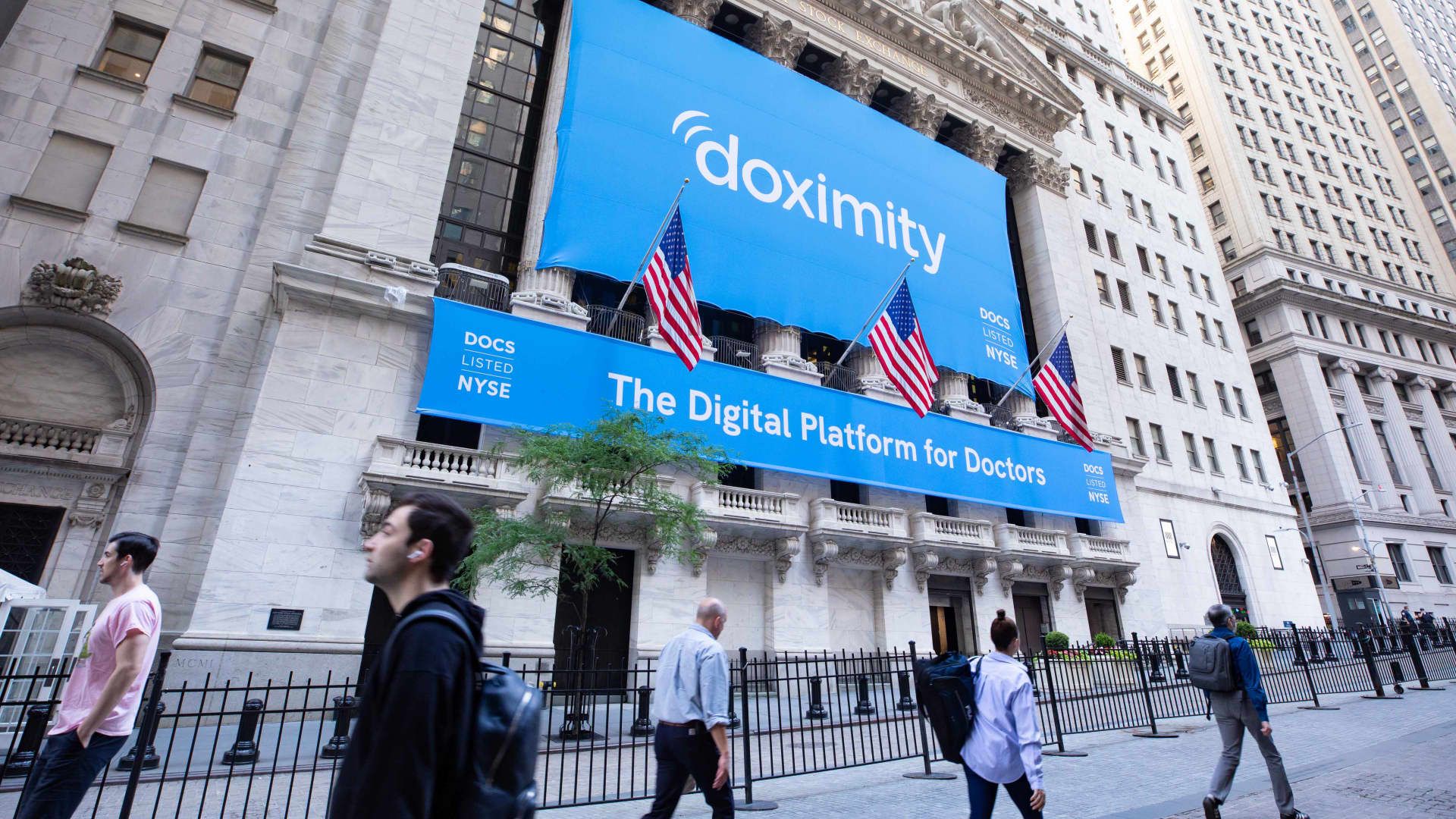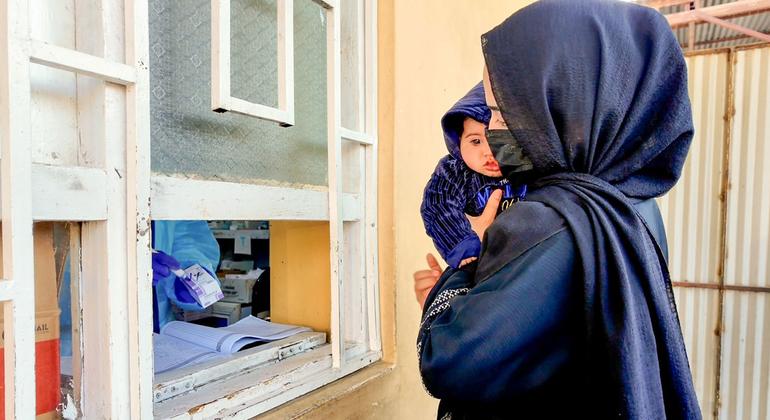Doximity on the New York Stock Exchange for its IPO, June 24, 2021.
Source: New York Stock Exchange
If the Covid era marked a boom time for digital health companies, 2024 was the decisive moment.
In a year in which the Nasdaq jumped 32%, surpassing 20,000 for the first time this month, healthcare technology providers suffered greatly. Of the 39 public digital health companies analyzed by CNBC, about two-thirds have fallen over the year. Others are now out of business.
There were some standout stars, such as Health for him and herwhich was boosted by the success of its popular new weight loss offering and its position in the GLP-1 craze. But that was an exception.
While there were some company-specific challenges in the industry, overall it was an “inflection year,” according to Scott Schoenhaus, an analyst at KeyBanc Capital Markets who covers healthcare IT companies. Not all business models that seemed ready to explode during the pandemic have worked as planned, and companies have had to refocus on profitability and a more moderate growth environment.
“The pandemic was a big boost to demand and we were facing difficult and challenging comparisons,” Schoenhaus told CNBC in an interview. “Growth has clearly slowed for most of my names, and I think employers, payers, providers and even pharma are more selective and demanding of the digital health companies they partner with.”
In 2021, digital health startups raised $29.1 billion, surpassing all previous funding records, according to a report from Rock Health. Nearly two dozen digital health companies went public through an initial public offering or special purpose acquisition company, or SPAC, that year, up from the previous record of eight in 2020. Money flowed into issues influencing remote work and remote health as investors. sought growth with interest rates stuck near zero.
But as the worst waves of the pandemic subsided, so did the insatiable demand for new digital health tools. It has been a rude awakening for the sector.
“What we're still going through is an understanding of the best ways to address digital health needs and capabilities, and the push and pull of current business models and their success,” said Michael Cherny, an analyst at Leerink Partners. he told CNBC. “We are in a period of adaptation after Covid.”
GoodRx signage outside Nasdaq on the day of its initial public offering, September 23, 2020.
Source: GoodRx
Progynywhich offers benefit solutions for fertility and family planning, is down more than 60% so far this year. Teladoc Healthwhich once dominated the virtual care space, has fallen 58% and is 96% below its 2021 high.
When Teladoc acquired Livongo in 2020, the companies had a combined enterprise value of $37 billion. Teladoc's market capitalization now sits below $1.6 billion.
GoodRxwhich offers price transparency tools for medications, is down 33% so far this year.
Schoenhaus says many companies' estimates this year were too high.
Progyny cut its full-year revenue guidance in each earnings report in 2024. In February, Progyny predicted between $1.29 billion and $1.32 billion in annual revenue. By November, the range had narrowed to between $1.14 billion and $1.15 billion.
GoodRx also repeatedly cut its full-year 2024 guidance. What was between $800 million and $810 million in May was reduced to $794 million in November.
In Teladoc's first-quarter report, the company said it expected full-year revenue of between $2.64 billion and $2.74 billion. The company withdrew its outlook in its second quarter and reported consecutive year-over-year declines.
“This has been a year of embracing the growth prospects of many of my companies, so I think we can finally look at 2025 as perhaps a better year in terms of setups,” Schoenhaus said.
While overzealous forecasts tell part of the digital health story this year, there were some notable stumbles at particular companies.
dexcomwhich makes diabetes and glucose monitoring devices, is down more than 35% so far this year. The stock fell more than 40% in July (its steepest drop yet) after the company reported disappointing second-quarter results and issued weak full-year guidance.
CEO Kevin Sayer attributed the challenges to a restructuring of the sales team, fewer new customers than expected and lower revenue per user. Following the report, JPMorgan Chase analysts marveled at “the magnitude of the downside” and the fact that it “appears to be largely self-inflicted.”
genetic testing company 23yyo had a particularly difficult year. The company went public via a SPAC in 2021, valuing the business at $3.5 billion, after its at-home DNA testing kits skyrocketed in popularity. The company is now worth less than $100 million, and CEO Anne Wojcicki is trying to keep it afloat.
In September, all seven independent directors resigned from 23andMe's board, citing disagreements with Wojcicki over the “strategic direction of the company.” Two months later, 23andMe said it planned to cut 40% of its workforce and close its therapeutics business as part of a restructuring plan.
Wojcicki has repeatedly said that he intends to make 23andMe private. The stock is down more than 80% so far this year.
The bright spots of digital health
His and hers products are shown.
him and her
Investors in Hims & Hers had a much better year.
Shares of the direct-to-consumer market have risen more than 200% so far this year, pushing the company's market capitalization to $6 billion, thanks to growing demand for LPG-1.
Hims & Hers began prescribing compounded semaglutide through its platform in May after launching a new weight loss program late last year. Semaglutide is the active ingredient in Nordiskthe blockbuster drugs Ozempic and Wegovy, which can cost around $1,000 a month without insurance. Compounded semaglutide is a cheaper, more personalized alternative to brand-name medications and can be produced when brand-name treatments are in short supply.
Hims & Hers will likely have to contend with dynamic regulatory and supply environments next year, but even before adding LPG-1 compounds to its portfolio, the company said on its February earnings call that it expects its profit loss program peso to generate more than $100 million in revenue by the end of 2025.
doximitya digital platform for medical professionals, also had a strong 2024, with its share price more than doubling. The company's platform, which for years has been compared to a LinkedIn for doctors, allows doctors to stay up-to-date on medical news, manage paperwork, find referrals and conduct telehealth appointments with patients.
Doximity generates revenue primarily through its recruiting solutions, telehealth tools, and marketing offerings for clients such as pharmaceutical companies.
Leerink's Cherny said Doximity's success can be attributed to its efficient operating model, as well as the “differentiated mousetrap” it created due to its reach into the physician network.
“DOCS is a rare player in healthcare IT in that it is already profitable, generating strong incremental margins and has consistent growth,” Leerink analysts, including Cherny, wrote in a November note. The company raised its price target on the stock to $60 from $35.
Another highlight this year was Oscar Healththe technology-based insurance company co-founded by Joshua Kushner of Thrive Capital Management. Its shares are up almost 50% so far this year. The company has approximately 1.65 million members and plans to expand to around 4 million by 2027.
Oscar showed strong revenue growth in its third-quarter report in November. Sales rose 68% from a year earlier to $2.4 billion.
Additionally, two digital health companies, road star and Tempus AItook the leap and went public in 2024.
The IPO market has been largely dormant since late 2021, when rising inflation and rising interest rates took investors off the risk. Few technology companies have gone public since then, and no digital health companies held initial public offerings in 2023, according to a report from Rock Health.
Waystar, a healthcare payment software provider, has seen its shares rise to $36.93 from its IPO price of $21.50 in June. Tempus, a precision medicine company, hasn't fared as well. Its shares have fallen to $34.91 from its IPO price of $37, also in June.
“Valuations will hopefully be more supportive of opportunities for other companies that have remained in the background as private companies over the last few years.” Schoenhaus said.
Out with the old
The Nasdaq MarketSite is seen on December 12, 2024 in New York City.
Miguel M. Santiago | fake images
Several digital health companies left the public markets entirely this year.
Cue Health, which performed Covid testing and counted Google as one of its first clients, and Better Therapeutics, which used digital therapies to treat cardiometabolic conditions, closed operations and were delisted from the Nasdaq.
Revenue cycle management company R1 RCM was acquired by TowerBrook Capital Partners and Clayton, Dubilier & Rice in an $8.9 billion deal. Similarly, Altaris purchased Sharecare, which runs a virtual health platform, for approximately $540 million.
Commure, a privately held company that offers tools to simplify doctors' workflows, acquired medical AI writing company Augmedix for about $139 million.
“There was a lot of competition that came into the market during the pandemic years, and we've seen some of that competition removed from the markets, which is a good thing,” Schoenhaus said.
Cherny said the sector is adapting to a post-pandemic period and digital health companies are figuring out their role.
“We are still moving through what could almost be called digital health 1.1 business models,” he said. “It's great to say we do things digitally, but it only matters if you have some focus to impact the 'triple aim' of healthcare: better care, more convenience and lower cost.”












